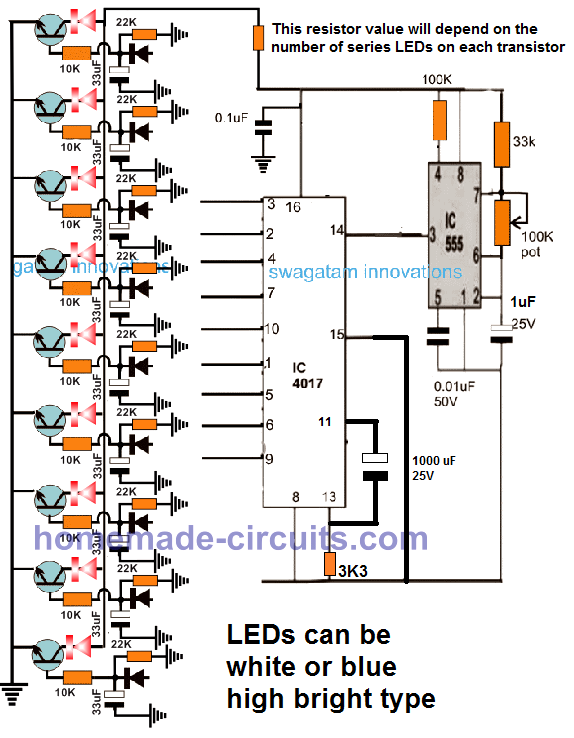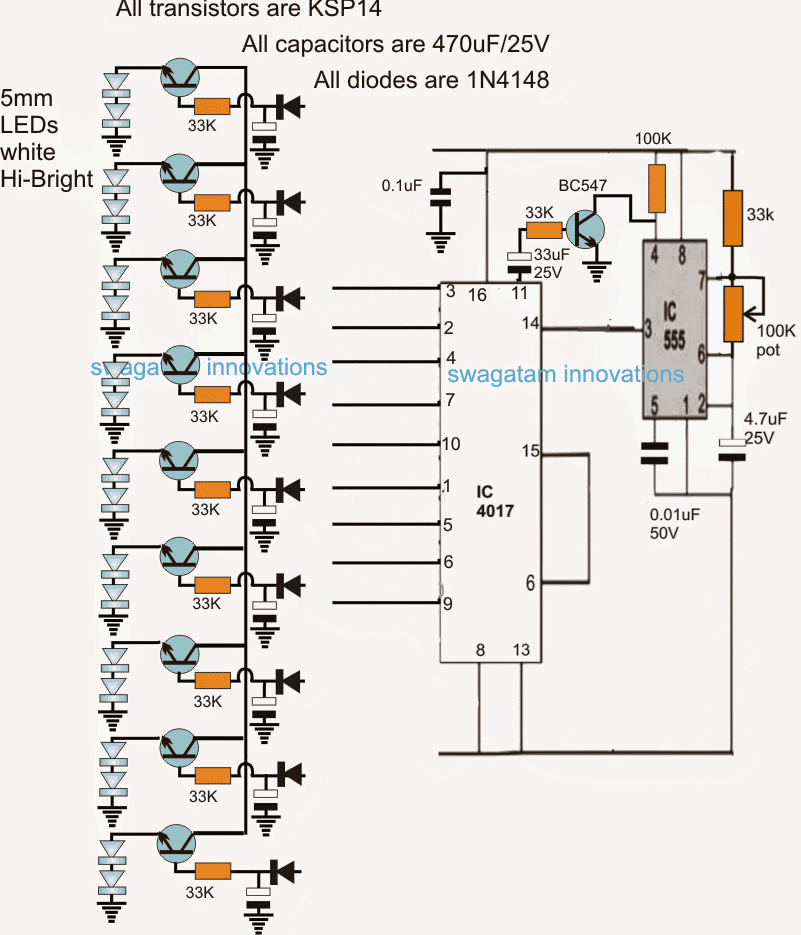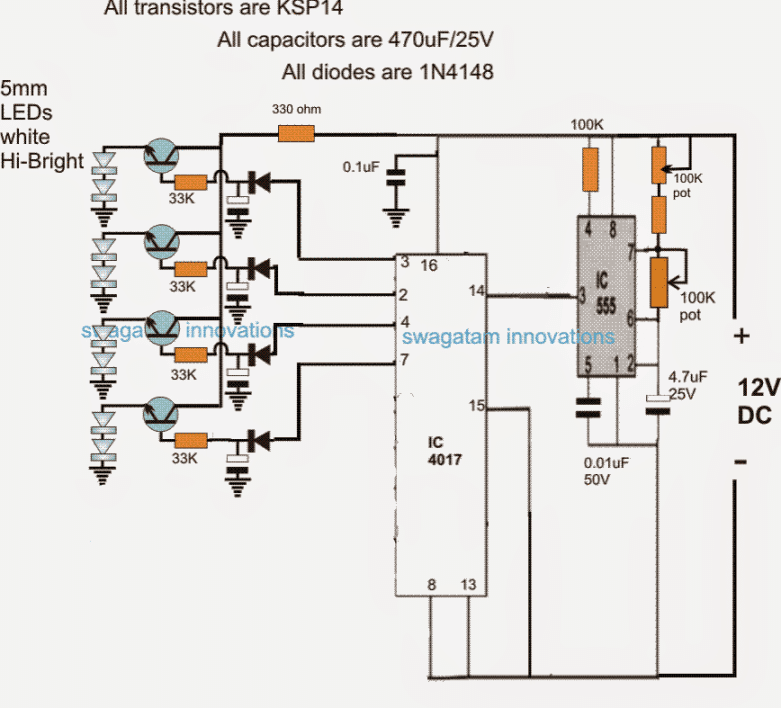In this post I have explained how to design an intriguing LED light effect that generates a collapsing metor shower like appearance. The idea was requetsed by Mr.Pinto Mondal.
Technical Specifications
I am very grateful of your work. Sir I want to make a circuit,which available in the market like 1 or 1.5ft long led light stick and the led flow's from up to down ,like water flow's slowly down from up.
so please sir help me out the circuit, the name is "rain tube led string" size 50cm on Internet I found another name hot meteor shower
Thanks
Pinto Mondal
What is LED Meteor Shower
As the name suggests, the proposed meteor shower or rain tube LED light circuit imitates a falling meteorite, collapsing in the sky.
Some of the other names for this project can be as given below:
- Falling LED light circuit
- Dropping LED Light circuit
- Slow Fade Running LED circuit
- Shooting Star LED Effect Circuit
The effect begins with a sequentially incrementing bar graph type of illumination which suddenly begins collapsing from the rear until its completely OFF, the effect keeps on repeating, quite resembling a chasing and collapsing meteorite in the sky.
When connected in groups, the visual experience can be quite a mesmerizing.
UPDATE
While practically verifying the circuit I found that the meteor shower effect could be improved and made more powerful by introducing the LEDs at the collector side of the transistor.
The revised circuit diagram can be seen below:

Parts List
All resistors are 1/4 watt 5%
- 10K - 9
- 22k - 9
- 33k - 1
- 100k pot - 1
- 3k3 - 1
- 1N4148 - 9
- IC 4017 - 1
- IC 555 - 1
- BC547 - 9
- LEDs Blue/RED - 9 to 36 (1 to 4 in series on each channel)
- 33uF/25 - 9
- 1uF/25V - 1
- 1000uF/25 - 1
- 0.1uF - 1
Note: The 100K on IC 555 pin#4 can be removed and pin#4 connected directly to the positive line.
The 1000uF can be reduced, if the 3k3 is increased proportionately.
Video Demonstration
PLEASE IGNORE THE DESIGN DISCUSSED IN THE FOLLOWING SECTIONS BECAUSE IT IS AN OLDER DESIGN AND HAS NOT BEEN VERIFIED THROUGH PRACTICAL TESTING.
Circuit Diagram

The idea could be achieved through the circuit represented above, using a Johnson's decade counter and a 555 astable clock generator circuit.
How it Works
It's basically a LED chaser circuit with a delay effect that's introduced at the base of each LED driver transistor. The charge stored in the capacitors hold the LED illumination for some moment until shutting them off gradually at the same sequencing rate as these were earlier illuminated....creating the fading collapsing effect of a meteor shower.
The IC 4017 outputs produce a jumping high or shifting logic high across its pin#3 to pin#9 in response to the clock signals fed at its pin#14 by the IC 555. The speed of this sequencing can be adjusted and tailored as per preference with the help of the 100k pot associated with pin#7 of the IC 555
The sequencing begins from pin#3 of the IC 4017 and proceeds until the sequence reaches pin#9 of the IC, during this course of travel, the LEDs illuminate in a bar graph form, due to the holding charge within the base capacitors of the transistors.
By the time the sequence reaches pin#9, the capacitor across that bases of the transistors begin losing there holding power as these are discharged sequentially, such that the LEDs too begin shutting from pin#3 towards pin#9, until all the LED are shut off.
However until this process is completed successfully, the IC 555 must somehow be disabled otherwise the sequence will reset back to pin#3 of the IC 4017 before the LED are able to shut off for evolving the desired meteor shower effect...and the whole purpose of the design might be nullified.
In order to ensure this, as soon as the sequence reaches pin#9, and subsequently to pin#11, the pin#11 holds pin#4 of the 555 to ground disabling the IC for some moment until the fading or the collapsing effect of the sequence is implemented across the LEDs. The time delay responsible for this must be precisely set by adjusting the base resistor of BC547 transistor at pin#11 of IC 4017.
If you are not interested to include the above explained pin#11 stage, the other alternative is to use the LEDs driver stages only up to pin#5, and allow the remaining pinouts to be blank, such that the sequencing logic while crossing these blank pins provide the required time delay for the collapsing effect to complete.
The idea can also be implemented using 1 watt LeDs for enabling brighter and more robust meteor shower LED effect....the only change required for this would be to replace all the transistors with TIP122,and make sure the LEDs are mounted on adequately large heatsinks.
R/C Delay Components Selection is Important
In this circuit the timing resistors and capacitors across the transistor bases play an important role for enhancing or degrading the desired meteor shower light effect...therefore the values must be selected carefully and tweaked through experimentation until the most impressive outcome is achieved.
The above circuit can be simplified to an extent by implementing the modifications as shown in the following image, although the effect will not be as interesting compared to the original design, the LED meteor shower effect will be still effectively displayed.
Simplified Schematic

